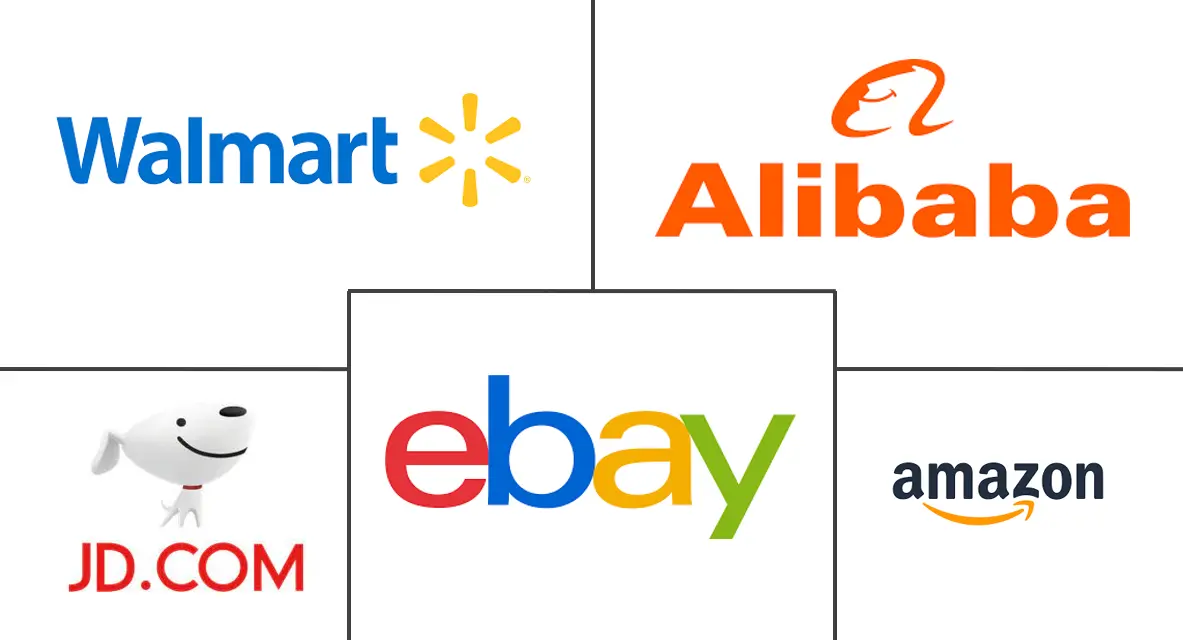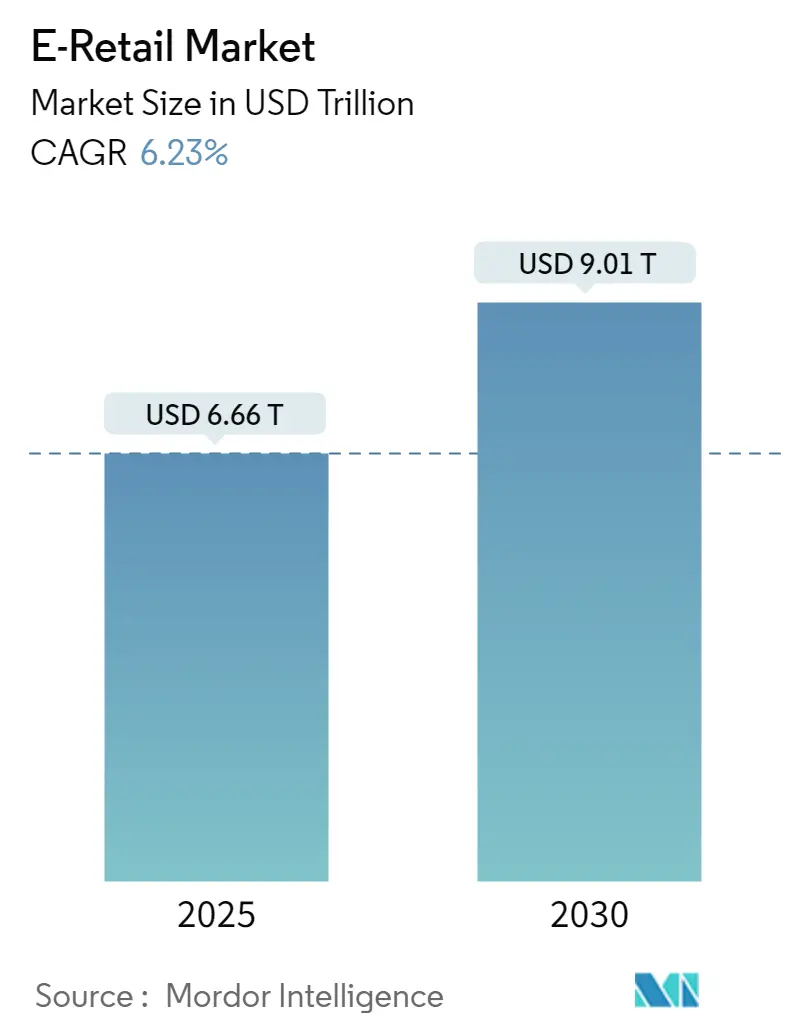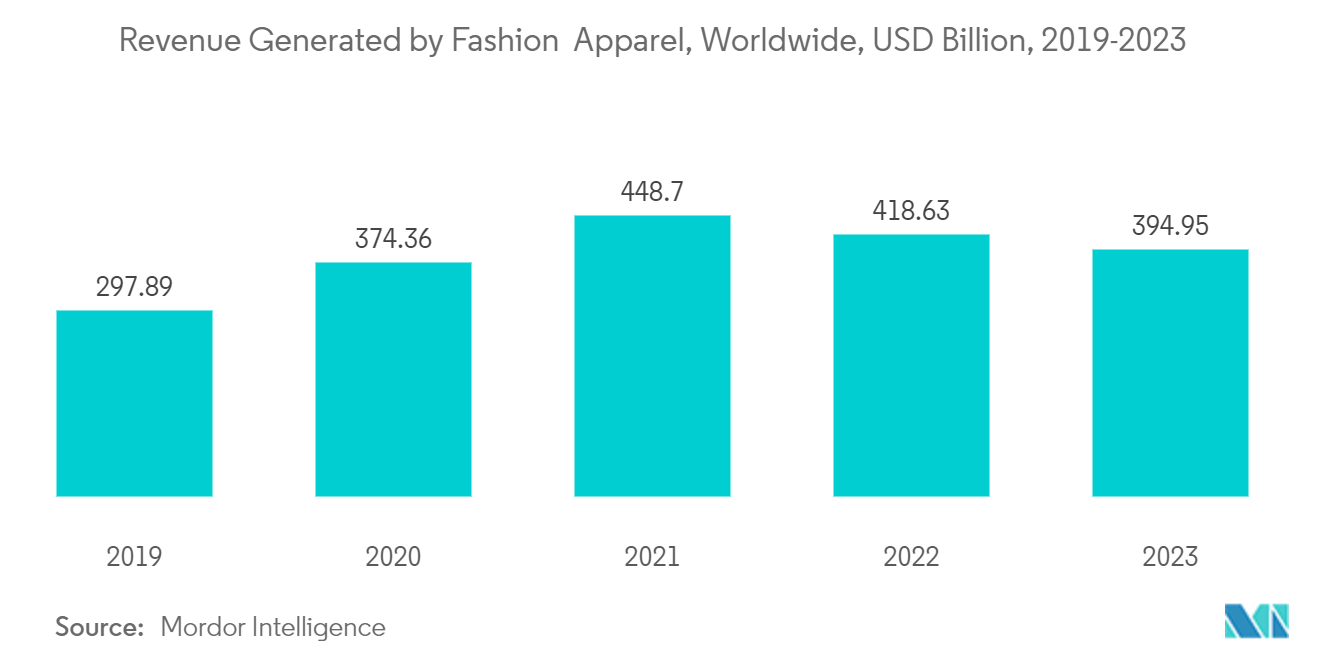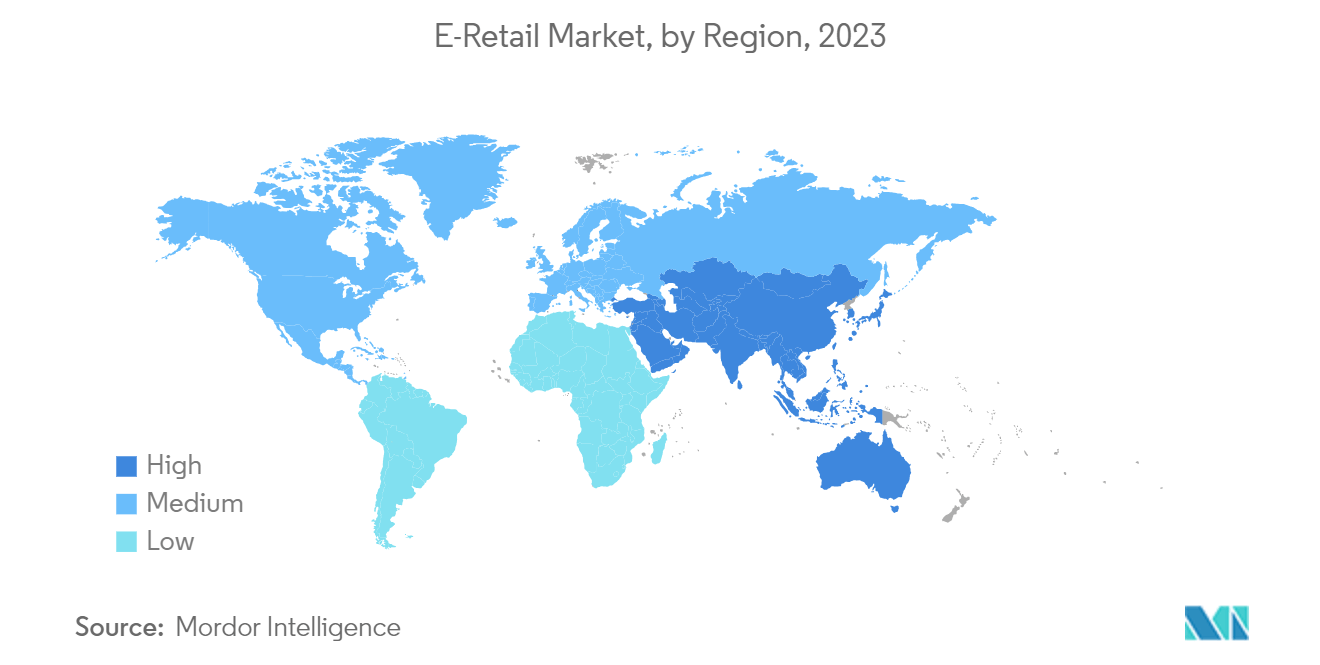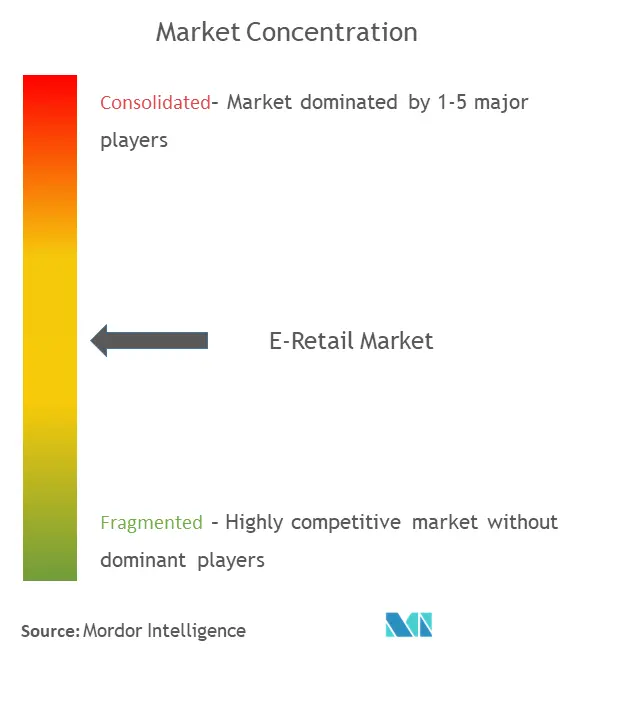Online Retail Market Analysis
The E-Retail Market size is estimated at USD 6.66 trillion in 2025, and is expected to reach USD 9.01 trillion by 2030, at a CAGR of 6.23% during the forecast period (2025-2030).
The market was impacted by COVID-19 as the travel restrictions were increased. However, after the restrictions were lifted, the market witnessed growth as many people started ordering from online websites. In today's world, the best way to capture consumers' attention and wallet share is to provide seamless, vibrant shopping experiences that go across channels. Today's shoppers have broadly adopted the convenience of shopping online so much that online retail sales continue to grow in double digits, while 'brick-and-mortar' retail sales are either in low single digits or are receding. As a result, retailers are making significant reserves to capitalize on the chance to increase market share and revenues. These investments in e-commerce and related digital capabilities can be improved by targeting new markets around the world.
E-commerce is expected to become the largest retail channel in the world over the forecast period, outpacing sales through retail outlets, such as supermarkets, independent grocers, and apparel and footwear retailers, among others. Global retail e-commerce sales recorded a steady growth of more than 6%. This growth was largely influenced by the Asia-Pacific. In the digitally maturing markets of Central and Eastern Europe, as well as parts of Southeast Asia, e-commerce accounted for less than 5% of the retail sales. The same was true for regions where economic factors had slowed down the e-commerce sales growth, such as Latin America and the Middle East and Africa.
Online Retail Market Trends
The Fashion and Apparel Sector Thrives in the Global E-Retail Boom
The global e-retail market has witnessed a remarkable surge in demand, with the fashion and apparel sector emerging as a frontrunner. As online shopping gains traction, fashion has become a coveted category for e-commerce consumers worldwide. A key catalyst behind this trend is the convenience that online shopping offers. From the convenience of their homes, shoppers can effortlessly explore a plethora of clothing options, delve into various brands, compare prices, peruse reviews, and make purchases, all with a few clicks, eliminating the need for physical store visits.
Moreover, the ascent of social media, particularly platforms like Instagram and Pinterest, has transformed them into virtual fashion runways. These platforms not only showcase the latest trends but also serve as a hub for fashion inspiration and influencers. This easy access to fashion content has further stoked consumer interest, propelling the demand for clothing in the e-retail realm.
Additionally, the e-commerce sector's strides in logistics and shipping have played a pivotal role in bolstering the fashion sector's e-retail demand. Shoppers now enjoy swift and dependable delivery services, complemented by hassle-free return and exchange policies, elevating their overall shopping experience.
Asia Pacific's E-Retail Market Surges, Fueled by Expanding Middle Class, and Innovative Players
The Asia Pacific region has cemented its position as a dominant force in the e-retail market, witnessing remarkable growth and emerging as a pivotal player on the global digital commerce stage. A key driver behind this surge in Asia Pacific's e-retail market is the rising affluence of its middle class. With greater purchasing power, more individuals are turning to online shopping. Notably, nations like China, India, and Southeast Asian countries have wholeheartedly embraced e-commerce, driving demand for a diverse array of products, spanning from fashion and electronics to home goods.
Another catalyst for the region's e-retail boom is the presence of industry giants. Companies like Alibaba, JD.com, and Lazada have reshaped the e-commerce landscape in Asia Pacific. These platforms offer an extensive product range, competitive pricing, and efficient logistics, drawing in a substantial customer base. Moreover, their adoption of innovative marketing techniques, like live-streaming shopping events and gamification, has struck a chord with consumers, further propelling the e-retail market's growth.
Notably, cross-border e-commerce is gaining momentum in Asia Pacific. With improved logistics and delivery options, consumers are increasingly open to exploring international products and brands. In response, e-retail platforms are diversifying their offerings, bringing a global marketplace experience to consumers.
Online Retail Industry Overview
The report provides an overview of the major international players operating in the e-retail market. Currently, some of the major players are dominating the sector in terms of revenue share. However, minor companies (mid-size and small) are focusing on improving their presence by securing new contracts and entering new markets. Some key players include eBay, Alibaba Group Holdings Ltd, Walmart Inc., JD.com Inc., and Amazon Inc.
Online Retail Market Leaders
-
Alibaba Group Holdings Ltd
-
Walmart Inc.
-
JD.com Inc.
-
Amazon Inc.
-
eBay
- *Disclaimer: Major Players sorted in no particular order
Online Retail Market News
In November 2023, Amazon inked a partnership with Meta. This strategic partnership will combine Meta's well-known social media platforms, Facebook and Instagram, with Amazon's enormous product selection to completely transform online shopping.
In July 2023, eBay acquired Certilogo, an AI-powered apparel and fashion goods authentication provider.
Online Retail Industry Segmentation
E-retail allows customers to buy services and products from sellers via the internet. A complete background analysis of the market, which includes an assessment of emerging trends by segments and regional markets, significant changes in market dynamics, and a market overview, is covered in the report.
The e-retail market is segmented by product and geography. By product, the market is sub-segmented into home appliances and electronics, clothing, footwear and accessories, food and personal care, furniture and home decor, and other products. By geography, the market is sub-segmented into North America, Europe, Asia-Pacific, Middle East and Africa, and South America. The report offers market size and forecasts in value (USD) for all the above segments.
.
| By Product | Home Appliances and Electronics | ||
| Clothing, Footwear, and Accessories | |||
| Food and Personal Care | |||
| Furniture and Home Decor | |||
| Other Products | |||
| By Geography | North America | United States | |
| Canada | |||
| Rest of North America | |||
| Europe | Germany | ||
| France | |||
| Italy | |||
| Spain | |||
| Rest of Europe | |||
| Asia-Pacific | China | ||
| Japan | |||
| Australia | |||
| India | |||
| South Korea | |||
| Rest of Asia-Pacific | |||
| Middle-East and Africa | Saudi Arabia | ||
| Egypt | |||
| United Arab Emirates | |||
| Rest of Middle East and Africa | |||
| South America | Argentina | ||
| Colombia | |||
| Rest of South America | |||
Online Retail Market Research FAQs
How big is the E-Retail Market?
The E-Retail Market size is expected to reach USD 6.66 trillion in 2025 and grow at a CAGR of 6.23% to reach USD 9.01 trillion by 2030.
What is the current E-Retail Market size?
In 2025, the E-Retail Market size is expected to reach USD 6.66 trillion.
Who are the key players in E-Retail Market?
Alibaba Group Holdings Ltd, Walmart Inc., JD.com Inc., Amazon Inc. and eBay are the major companies operating in the E-Retail Market.
Which is the fastest growing region in E-Retail Market?
Asia Pacific is estimated to grow at the highest CAGR over the forecast period (2025-2030).
Which region has the biggest share in E-Retail Market?
In 2025, the North America accounts for the largest market share in E-Retail Market.
What years does this E-Retail Market cover, and what was the market size in 2024?
In 2024, the E-Retail Market size was estimated at USD 6.25 trillion. The report covers the E-Retail Market historical market size for years: 2020, 2021, 2022, 2023 and 2024. The report also forecasts the E-Retail Market size for years: 2025, 2026, 2027, 2028, 2029 and 2030.
Our Best Selling Reports
Internet Retail Industry Report
The E-Retail and Retail E-Commerce markets are thriving, propelled by the growing trend of online shopping across diverse segments. These markets, encompassing marketplace sales, third-party e-retailers, and direct sales through own websites, are broadening their reach across various product categories including clothing, footwear, accessories, home appliances, and more. Key drivers of this expansion include easy return policies, attractive discounts, product bundling, and cutting-edge technologies like augmented reality, which collectively enhance the consumer shopping experience. Additionally, the surge in smartphone usage, increased internet penetration, and a shift in consumer preferences towards online shopping are fueling market growth. Technological innovations such as artificial intelligence, chatbots, and augmented reality are further transforming the retail e-commerce landscape by offering personalized shopping experiences and broadening global market reach. Despite facing challenges such as data privacy concerns, the future of both E-Retail and Retail E-Commerce markets looks promising, with ample opportunities for growth and expansion. For detailed insights, Mordor Intelligence™ Industry Reports provide an in-depth analysis, including market share, size, revenue growth rate, and a forecast outlook, available as a free report PDF download.

